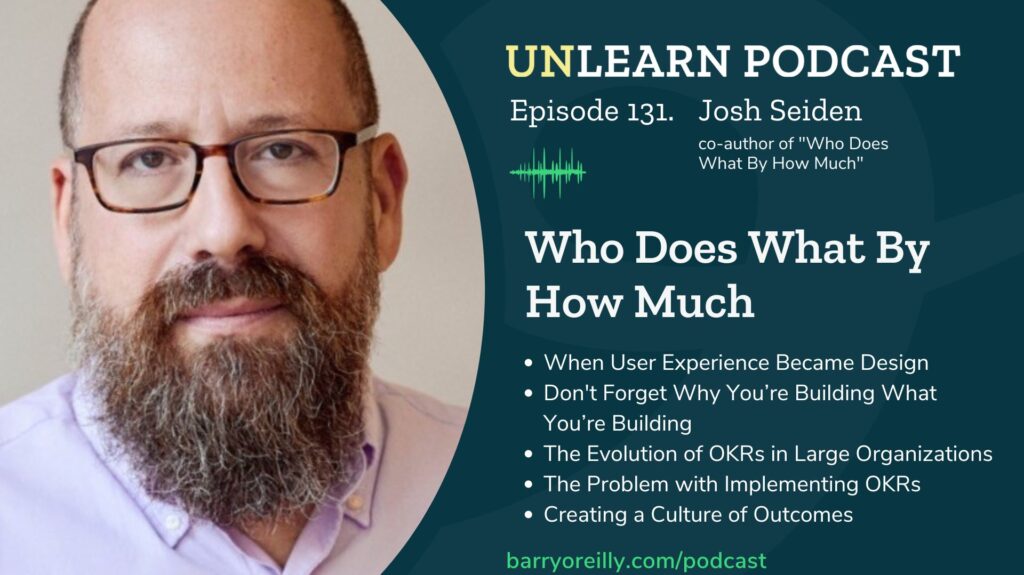The definition of success can change everything. Properly defined, you have an agile organization where each team member can contribute fully. Poorly defined, you have stagnant teams and users that don’t like the products. In this episode of the Unlearn Podcast, host Barry O’Reilly sits down with Josh Seiden, a sought-after designer, strategy consultant, and coach. Together, they explore the importance of understanding user behavior, how that behavior can be translated into goals, and how company alignment on Outcomes and Key Results can drive business outcomes.
Josh Seiden has collaborated with top-tier brands such as PayPal, Johnson & Johnson, and 3M. His expertise lies in launching and building innovative products and services, as well as fostering agile and entrepreneurial mindsets within organizations. He is the author of “Outcomes Over Output” and co-author of “Who Does What By How Much,” “Sense and Respond,” and “Lean UX,” all cementing his reputation as a thought leader in the field of user-centered design and business strategy.
When User Experience Became Design
We know now that understanding how users will experience a product is a critical part of designing a new product, but back in the 90’s when Josh began his career in the industry, it was a radical idea. “A friend told me, ‘We’re hiring designers here,’ and I laughed, ‘Why are you telling me this? I’m not a designer.’ But that thing you’re doing here, we call that design,” Seiden recalls. This unconventional designation became an entire industry, and his unconventional path to it meant he brought a unique perspective to the field of user experience design. Barry notes that this is a story that gets told again and again on the Unlearn podcast; that the conventional wisdom on how to find or become an expert is often wrong. [Listen from 2:40]

Don’t Forget Why You’re Building What You’re Building
Barry points out that companies often measure things like the speed of production, but forget to measure the consumer behavior change that would really demonstrate the value of the project. Josh explains that measurability is important over the life of a project, but keeping the focus on outcomes for actual people is the most important thing to track. This is the key premise of Outcomes over Output that answers the question: what is an outcome? Josh’s definition, “An Outcome is a measurable change in user behavior that creates value.” If you need to identify the outcome you should be measuring for your company, answer three questions: Who?, Does What?, and By How Much? [Listen from: 10:45]
The Evolution of OKRs in Large Organizations
Design thinking works at the team level very easily, and as the industry developed the question became how to do it at scale? Objectives and Key Results (OKRs) have emerged as a tool for helping large organizations work in agile ways. Josh explains how OKRs can be used to manage outcomes at scale: “The O is an objective. What’s the big audacious goal? And then the KR is the result. How do you measure it? The key result. For most people who look at the system, they understand that […] you want those Key Results to be outcomes.” This way of thinking helps large enterprises maintain focus and drive impactful results by clearly defining and measuring success as it matters to the people using the product. [Listen from 22:00]
The Problem with Implementing OKRs
Organizational Inertia can be a major challenge to overcome when implementing OKRs. Josh discusses common pitfalls, such as merely renaming old practices without genuine change and the temptation to consider an objective fulfilled when a certain number of tasks are complete. Unfortunately, it’s easy to create something excellent that provides no real value. Barry is familiar with the problem: “If just the customer would use it the way I thought they were going to use it.” Josh says there is a trick to OKRs: “They don’t tell you what to do. They ask the right question.” When you get to the right question, and define the system of outcomes you need across the different teams involved, you get both autonomy and accountability, and unlock the whole creative power of the teams across the company. A rhythm of checking in on progress and course-correcting keeps the process agile. [Listen from 26:00]
Creating a Culture of Outcomes
Barry points out that asking for help is a very different thing, and creates a very different feeling on a team than providing a list of tasks to accomplish on a specific timeline. Josh agrees and says there is an interesting thing that starts to happen when trying to align an organization around an outcome: “when you talk about the outcome as very specifically customer or user behavior, it’s the teams that are closest to the customer who can actually tell you what the outcomes are that will be valuable.” The people at the top rarely have that kind of insight. Because everyone sees different things based on their role within an organization, prioritizing the flow of information and insights throughout the company allows everyone to focus on the most important thing: the outcomes. [Listen from 32:00]















